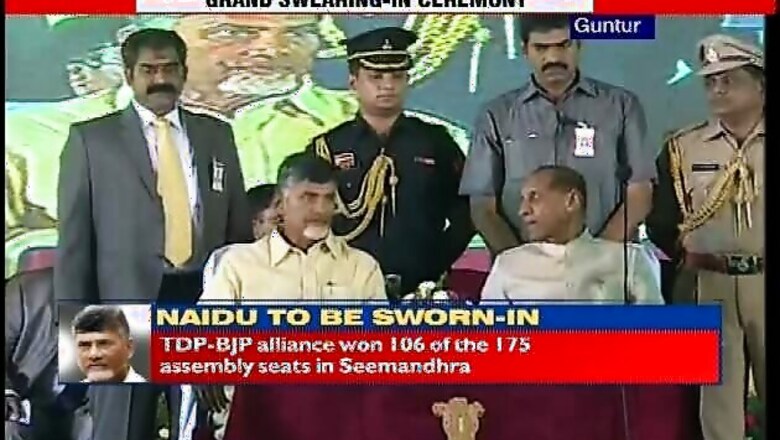
views
Vijayawada: As he took oath of office on Sunday evening, Nara Chandrababu Naidu has earned a unique distinction of becoming the first Chief Minister of a new state in addition to being the longest-serving CM of Andhra Pradesh.
Chandrababu served as the Chief Minister of (united) Andhra Pradesh for eight years, eight months and 13 days (from September 1, 1995 to May 13, 2004) the longest tenure for any CM of AP and now he has become the first CM of (bifurcated) AP.
Chandrababu also has other distinctions like being the youngest MLA in the state and the youngest minister at the age of 28 when he was first inducted as minister for cinematography in the then Cabinet of T Anjaiah in 1978.
A seven-time MLA, he also holds the record as the longest-serving Leader of Opposition in Andhra Pradesh between 2004 and 2014.
Born on April 20, 1950, into a middle-class agricultural family at Naravaripalle near the temple-town of Tirupati, Chandrababu started off as a students' union leader in Sri Venkateswara University while pursuing his Masters in Economics. He joined the Youth Congress in 1975 and was elected as an MLA for the first time in 1978 from his native Chandragiri constituency. Chandrababu had to drop his PhD programme in economics after he became a minister.
While serving as minister, Chandrababu caught the Telugu silver screen legend N T Rama Rao's eye and a relationship was thus built when NTR gave his second daughter Bhuvaneswari in marriage to the former in 1980.
Chandrababu lost the 1983 election as Congress nominee in the newborn Telugu Desam's wave but within months quietly switched over to the fledgling party floated by his father-in-law.
He was made in-charge of Karshaka Parishad, the farmers' council established by the NTR government, and later the general secretary of TDP, to emerge as the key strategist and organiser of party affairs.
In 1989, Chandrababu shifted to Kuppam Assembly constituency bordering Tamil Nadu and Karnataka and had been elected to the Legislature consecutively from there.
In 1994, he became minister for finance and revenue in NTR's Cabinet but in August 1995 led an internal party coup to dislodge his father-in-law from the Chief Minister's chair and took over the reins with the support of majority of MLAs.
Chandrababu simultaneously became president of the TDP and took full control of the party after NTR's demise in January 1996, but had to carry the tag of a "backstabber" for many years thereafter.
He then played a key role in national politics as well and helped form the United Front government with non-Congress, non-BJP parties. He was "offered" the Prime Minister's post in 1997 but Chandrababu "rejected" it saying he wanted to dedicate himself to the development of AP.
As Chief Minister, Chandrababu ushered in reforms, both in economics and governance, and launched pioneering initiatives like e-governance, e-Seva (electronic delivery of government services) and Citizens Charter.
He came out with a Vision-2020 policy document for the all-round development of the state and implemented it with passion. It, however, produced mixed results even as Chandrababu attracted flak for neglecting the critical rural development.
From a city famous for its pearls and biryani, Chandrababu turned Hyderabad into a major hub of Information Technology, attracting giants like Microsoft, Wipro, Google and several others to set up shop in the city.
A workaholic and a taskmaster, Chandrababu was hailed as the Chief Executive Officer of the state rather than Chief Minister and won international recognition for his administration. He even found place in the "dream team" of the World Economic Forum to which he was a regular invitee.
Successive years of drought, however, wreaked havoc on the rural economy in the state as farmers remained the worst sufferers, leading to a spate of suicides.
That, in a way, proved the undoing for Chandrababu as the TDP was voted out of power in 2004.
He also had to weather some political storms, mostly notably the exit of K Chandrasekhar Rao from the TDP and the launch of Telangana Rashtra Samiti with the only demand for bifurcation of the state.
He had to eventually give in to the separate state demand and alter the TDP's united AP policy.
In 2009, Chandrababu would have wrested power from the Congress but for the emergence of actor Chiranjeevi's Praja Rajyam Party (PRP) that cut into the anti-incumbency votes and helped YS Rajasekhara Reddy retain power. Thus, Chandrababu was relegated to the opposition leader's slot for a second successive term.
He faced the threat of political extinction as nobody gave TDP a chance of returning to power in 2014 in the face of a serious challenge posed by another new entrant YSR Congress of Jagan Mohan Reddy, son of YS Rajasekhara Reddy on the state's political scene.
The state bifurcation came as a blessing in disguise for Chandrababu as people saw hope only in him as a tall and "experienced" leader who could recreate the magic and build the new state of AP into a well-developed province.
The 2014 election mandate in AP was decisively in his favour. And, this will be by far the biggest political challenge for the shrewd campaigner.




















Comments
0 comment